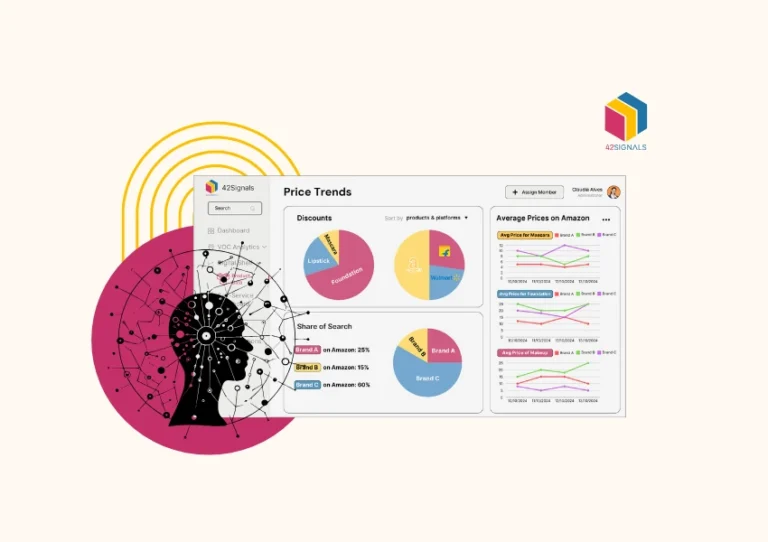Staying competitive and relevant in retail requires more than just offering a variety of products. Retailers need to focus on creating an optimized product assortment—one that not only meets customer demands but also drives sales and operational efficiency. This is where e-commerce analytics come into play. E-commerce analytics can help retailers make data-driven decisions about which products to prioritize, introduce, or phase out. By analyzing sales trends, customer preferences, and stock levels, retailers can fine-tune their product assortment to align with evolving market demands. In this guide, we’ll explore how to use e-commerce analytics to optimize retail goods assortment, covering everything from understanding consumer behavior to leveraging predictive analytics for forecasting demand.
Why Optimizing Retail Goods Assortment Is Crucial in Ecommerce?

Image Source: KoronaPOS
Product assortment refers to the range and variety of products offered by a retailer. It’s not just about quantity; it’s about offering the right mix of products that will attract customers and maximize sales. A well-curated product assortment considers factors such as customer preferences, seasonal trends, and stock availability.
Retail goods assortment optimization is particularly important as consumer behavior continues to evolve, driven by digitalization and shifting e-commerce retail trends. Retailers now have to be agile, adjusting their assortments quickly to meet customer expectations and stay competitive.
With the rise of online retail growth, retailers have access to vast amounts of data that can help shape their assortment strategy. Through advanced digital shelf analytics, predictive analytics, and competitor data analysis, retailers can create an assortment that not only meets the needs of their customers but also anticipates future trends.
How Does ECommerce Analytics Power Retail Goods Sourcing?

Image Source: Shopify
Retail product sourcing is one of the key aspects of product assortment management. Choosing the right products to source involves understanding customer preferences, market trends, and pricing dynamics. E-commerce analytics can help by offering insights into:
Sales Performance Analysis:
Granular Profitability: Analyzing not just sales volume, but profit margins (gross and net), GMROI (Gross Margin Return on Inventory Investment), and contribution to overall category profitability. A high-volume item with low margins or high holding costs might be less desirable than a moderate seller with excellent profitability.
Seasonality & Trend Lifecycle: Identifying product lifecycles (introduction, growth, maturity, decline) and seasonal patterns to time sourcing decisions accurately. Analytics helps predict when to ramp up sourcing for peak seasons and when to taper off for declining trends.
Basket Affinity Analysis: Understanding which products are frequently purchased together. This informs bundle sourcing, complementary product introductions, and strategic placement decisions.
Return Rate Analysis: Identifying products with high return rates due to quality issues, inaccurate descriptions, or customer dissatisfaction. This is crucial for supplier evaluation and deciding whether to continue sourcing specific items.
Customer Preferences and Behavior:
Search & Browse Analytics: Analyzing what customers are searching for on your site (including terms yielding no results) and which categories/pages they browse most reveals unmet demand and emerging interests, guiding sourcing for new products or variants.
Review & Sentiment Analysis: Mining customer reviews and ratings provides direct feedback on product quality, features, sizing, and pain points. This intelligence is vital for selecting better products, negotiating improvements with suppliers, or discontinuing problematic items.
Wishlist & Save-for-Later Analysis: Identifying products customers desire but haven’t purchased yet indicates potential demand and price sensitivity, informing sourcing negotiations and promotional strategies.
Segmentation & Personalization: Understanding preferences of different customer segments allows for targeted sourcing strategies. E.g., sourcing premium versions for high-value segments or value packs for price-sensitive segments.
Competitive Intelligence:
Pricing Benchmarking & Strategy: Continuously monitoring competitor pricing (including discounts, promotions, and shipping costs) for identical or similar products is essential. Analytics helps determine optimal price points, identify opportunities for price leadership, and avoid margin erosion. Price tracking tools automate this process.
Assortment Gap Analysis: Systematically comparing your product range against key competitors highlights gaps (products they carry that you don’t) and surpluses. This identifies clear sourcing opportunities or areas for rationalization.
New Product Launch Tracking: Monitoring competitors’ new product introductions provides early signals of emerging trends and innovation, allowing for faster reactive or proactive sourcing.
Share of Voice & Visibility: Analyzing how prominently competitors feature certain products (e.g., homepage placement, category ranking) indicates their strategic focus and potential market demand.
Inventory Management:
Effective inventory management is a key component of retail product sourcing. By using e-commerce analytics, retailers can predict stock levels, avoid overstocking, and reduce stockouts.
- Demand Forecasting: Leveraging historical sales data for retail goods, seasonality, trends, and marketing calendars to predict future demand more accurately. This forms the bedrock of how much to source and when to place orders, minimizing capital tied up in inventory.
- Safety Stock Optimization: Analytics helps calculate optimal safety stock levels based on demand variability and supplier lead times, balancing the risk of stockouts against the cost of excess inventory.
- Supplier Performance & Lead Time Analysis: Tracking supplier reliability (on-time delivery, order accuracy) and lead times is critical for inventory planning. Poor-performing suppliers necessitate higher safety stocks or alternative sourcing. Analytics identifies bottlenecks.
- Digital Shelf Analytics for Availability & Compliance: Real-time monitoring ensures products are not only “in stock” in the warehouse but are live, available, and correctly displayed on the website across all channels. This prevents lost sales due to technical glitches or listing errors. It also ensures pricing and content accuracy vs. competitors.
How to Use ECommerce Analytics for Product Assortment Optimization?

Optimizing a retail goods assortment requires a strategic approach. Let’s break down how e-commerce analytics can help retailers achieve this:
1. Sales Trend Analysis of Retail Goods
One of the most powerful features of e-commerce analytics is its ability to track sales trends over time. By analyzing historical sales data, retailers can identify seasonal patterns, peak shopping periods, and product performance over time.
For example, if a retailer notices that certain products sell better during specific times of the year—like winter jackets or holiday decorations—they can adjust their product assortment to ensure these items are well-stocked in anticipation of high demand. Conversely, items that are consistently underperforming can be removed from the assortment.
Retailers can also track which product categories are growing or shrinking. For instance, e-commerce retail trends show a significant shift toward sustainable and eco-friendly products. Retailers can leverage this data to introduce more environmentally-conscious products and refine their product assortment based on consumer preferences.
2. Customer Behavior and Preference Analysis
Understanding customer behavior is crucial to optimizing product assortment. E-commerce analytics provides insights into customer demographics, buying habits, and product interactions. With this data, retailers can uncover trends in customer preferences, helping them curate a product assortment that aligns with these demands.
By analyzing customer reviews, ratings, and product interactions, retailers can gain insights into product desirability. For instance, if a particular product is receiving positive feedback and high engagement, retailers can prioritize it in their assortment and introduce related products that meet similar customer needs.
3. Predictive Analytics for Demand Forecasting of Retail Goods
Predictive analytics is a game-changer when it comes to optimizing retail goods assortment. By analyzing past sales data, seasonality, and current market trends, predictive models can forecast demand for specific products in the future. This helps retailers make smarter decisions about which products to introduce or phase out.
For instance, predictive analytics can help retailers adjust their assortments in real-time based on market fluctuations or consumer interest. If an unexpected surge in demand for a particular product occurs, retailers can quickly adjust their inventory and marketing efforts to capitalize on the trend. Predictive analytics can also assist in reducing waste by helping retailers avoid overstocking products that aren’t expected to perform well.
4. Using Digital Shelf Analytics for Product Performance Monitoring
Digital shelf analytics offers real-time insights into product availability, visibility, and performance on e-commerce platforms. It tracks how products are displayed on digital shelves and how consumers interact with them, helping retailers optimize product placement and assortment.
By using digital shelf analytics, retailers can identify which products are gaining traction and which are being overlooked. They can then adjust their assortment strategy by giving more prominence to high-performing products and improving the visibility of underperforming ones. This data can also help retailers identify gaps in their product assortment and introduce new products to fill those gaps.
5. Optimizing Pricing Strategies
Pricing is an integral part of product assortment optimization. By using e-commerce analytics, retailers can monitor competitor pricing strategies and adjust their own prices accordingly. This helps ensure that the product assortment remains competitive in the market.
Through price intelligence tools, retailers can track fluctuations in competitor pricing, map violations, and ensure their prices remain competitive. This dynamic pricing approach ensures that the product assortment remains attractive to customers while maximizing profitability.
How Digital Shelf Analytics Transforms Product Assortment?
The digital shelf is the virtual counterpart to the physical shelf in traditional retail, and it plays an integral role in influencing purchase decisions. Digital shelf analytics focuses on how products are displayed online, their visibility, pricing, and how they perform relative to competitors. Retailers can leverage digital shelf analytics to improve the assortment of their retail goods by optimizing product placement, pricing strategies, and promotional activities.
1. Monitoring Product Visibility
Analyzing product visibility on e-commerce platforms allows retailers to determine whether their products are being discovered by the right audience. Retailers can track how their products appear in search results, how often they are clicked on, and whether they are featured prominently on the site. This insight can help retailers optimize their product assortment by focusing on products that are gaining traction and making sure they are highlighted properly on the digital shelf.
2. Pricing Optimization in Retail Goods
Digital shelf analytics also allows retailers to monitor competitor pricing and adjust their own pricing strategies accordingly. By offering competitive prices or implementing dynamic pricing strategies based on demand, retailers can ensure that their products remain attractive to customers while maximizing profitability.
How ECommerce Analytics Boosts Retail Goods Assortment & Sales?

Image Source: RelexSolutions
Optimizing product assortment using e-commerce analytics offers numerous benefits to retailers:
- Increased Sales: By offering the right products at the right time, retailers can boost sales and customer satisfaction. Predictive analytics ensures that products are available when customers want them.
- Enhanced Customer Experience: By tailoring the product assortment to meet customer needs, retailers can improve the overall shopping experience, leading to higher customer loyalty and repeat purchases.
- Operational Efficiency: Retailers can streamline their inventory management, reducing stockouts and overstocking, ultimately leading to better cost management.
- Competitive Advantage: By leveraging competitor data and digital shelf analytics, retailers can stay ahead of market trends, ensuring their product assortment is always aligned with customer preferences and industry shifts.
Conclusion
As the retail industry continues to evolve, optimizing product assortment is more important than ever. By leveraging e-commerce analytics, retailers can make data-driven decisions that help them understand sales trends, customer behavior, and inventory needs. With tools like predictive analytics, digital shelf analytics, and competitor data analysis, retailers can create a product assortment that not only meets customer expectations but also drives sales and operational efficiency.
By adopting a data-driven approach to product assortment, retailers can stay competitive in today’s rapidly changing retail landscape. Embrace the power of e-commerce analytics and unlock the full potential of your retail goods assortment.
42Signals is designed to empower retailers to make data-driven decisions that lead to better product sourcing, smarter pricing strategies, and ultimately, greater success in the digital retail space. Schedule a demo today!
Frequently Asked Questions
What are retail goods?
Retail goods are products sold directly to consumers for personal use. Examples include:
- Clothing – T-shirts, jeans, jackets
- Electronics – Smartphones, laptops, headphones
- Groceries – Packaged foods, fresh produce, beverages
- Home goods – Furniture, kitchenware, décor items
- Personal care products – Shampoo, skincare, razors
- Toys and games – Board games, action figures, puzzles
These items are typically sold through physical stores, online platforms, or both.
What are retail products?
Retail products are tangible goods offered to individual consumers through retail channels like stores, websites, and mobile apps. They are typically non-industrial and meant for personal consumption. Retail products can fall under various categories such as apparel, electronics, beauty, home essentials, and food.
Retailers act as the final link in the supply chain, purchasing these products from manufacturers or wholesalers and selling them at a markup to the end user.
What are retail and consumer goods?
- Retail goods are the products available for sale in a retail environment. These include any items consumers can buy in stores or online.
- Consumer goods are products purchased by individuals for personal or household use, as opposed to business or industrial use.
All retail goods are consumer goods, but not all consumer goods are sold in a retail format. For example, a bulk pack of detergent sold to a business is a consumer good but not a retail product.
There are three types of consumer goods:
- Durable goods – Long-lasting items like appliances or furniture
- Non-durable goods – Consumables like food and cleaning products
- Services – Intangible offerings like haircuts or streaming subscriptions
What is considered retail?
Retail refers to the sale of goods or services directly to the end consumer, typically in small quantities. It includes:
- Brick-and-mortar stores – Supermarkets, clothing shops, electronics stores
- Online stores – Ecommerce platforms like Amazon, Walmart.com, Shopify stores
- Pop-up shops and kiosks – Temporary selling locations
- Direct-to-consumer (DTC) – Brands that sell their products straight to buyers without intermediaries
Any business that sells products or services to individuals, rather than businesses or wholesalers, is part of the retail sector.





